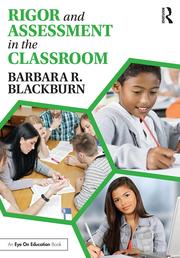How to Differentiate Rigor and Assessment
Rigor and Assessment in the Classroom
By Barbara R. Blackburn
(Routledge/Eye On Education, 2017 – Learn more)

Rigor and Assessment in the Classroom challenges the myth that rigor is creating work that is more difficult, instead emphasizing that rigor is the depth to which a student learns.

Early in the book, the author spends time talking about what is going to be covered in the text, then as readers progress, they are fully exposed to that content, effectively modeling some of the techniques that are being encouraged.
A design process for engaging rigor
The process of planning for effective rigor is aided by the author’s providing a cycle or design process to help a teacher focus on making each lesson engaging and rigorous at the same time without losing focus on the lesson objective. The text is heavy with examples in each chapter.
Instead of inventing a new wheel, Blackburn relies on outside research that has proven effective. She provides examples of formative, summative and differentiated assessments. Guiding the reader through challenging performance-based assessments, the author uses situations that are typically not thought of as performance based. She places an emphasis on meaningful assessment of the performance-based techniques – not just using a checklist to identify what was completed.
Blackburn states that different assessments may need to be utilized that are equally rigorous, based on the ability of the student. The standard doesn’t change based on the student, but the approach to achieving that standard can – both instructionally and through the assessment.
Effective differentiation
Differentiation starts with the presentation of the material and the work expected of the student. Homework can be differentiated by difficulty, structure, or learning style, all allowing for equal amounts of rigor. The assessments then are based on the ability of the student and the material provided.
The result is students are being tested at the ability they can achieve, whether struggling, average or gifted. The author provides several methods to create this differentiation to allow students to work at their level of rigor. All methods used will have some rigor built in; the assessment will use higher order questions.
Grading in a rigorous classroom can be a challenge. In Chapter 8, Blackburn provides discussion and technique in how to make the grading fair and effectively looks at the process of grading. She has excellent examples of how to engage students in the grading process, allowing them through guided discussions to have ownership in the result.
Constantly emphasizing quality of work and not just completion, Blackburn also tackles extra credit and group work, giving guidance on addressing these issues in a fair manner.
Though very little of the material presented was new to me, the way Blackburn collects and presents these best practices is refreshing and gives insights that should help a classroom teacher become more effective at providing rigor, allowing students to earn the grade that shows on their report card.
Best of all, by Blackburn’s definition, an effectively rigorous classroom will create a positive environment where real learning takes place at the ability level of the student.
Roy Palmer has taught printing, photography, drafting and technology classes at the middle school and secondary level in Kansas schools. He has also taught photography as an adjunct professor at a local community college. Palmer, an educator for 27 years, holds a Bachelor of Science in Education (Industrial Arts) and a Master of Science in Technology Education from Pittsburg State University in Kansas.

































